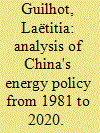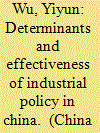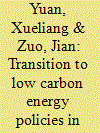| Srl | Item |
| 1 |
ID:
183587


|
|
|
|
|
| Summary/Abstract |
Looking back at four decades of China's energy policy (1981–2020), three momentous shifts can be said to have taken place. From the Sixth Five-Year Plan (1981) to the Ninth Five-Year Plan (2000), the focus was exclusively on improving energy efficiency. Subsequently, from the Tenth Five-Year Plan (2001) to the Eleventh Five-Year Plan (2010), energy security also became a major objective, as awareness of the gradual depletion of fossil fuels grew. From 2011 onwards (Twelfth and Thirteenth Five-Year Plans), China's energy policy has also aimed to ward off climate change. This policy evolution suggests that the Chinese economy has initiated a low-carbon energy transition since 2011. Nevertheless, this transition cannot be considered sustainable because the local government are reluctant to apply stringent institutional limitations to wealth-creating processes within their jurisdiction and because China's energy consumption is not decoupled from its economic growth and total environmental costs of renewable energy are not taken account. In seeking to usher in a sustainable energy system, the Chinese government needs to overcome three challenges: 1/an institutional challenge; 2/an economic challenge and 3/an environmental challenge.
|
|
|
|
|
|
|
|
|
|
|
|
|
|
|
|
| 2 |
ID:
163517


|
|
|
|
|
| Summary/Abstract |
This paper examines industrial policy in China over the period of the 9th - 12th Five-Year Plans (FYPs). Based on China's national and provincial FYPs and data disaggregated to the four-digit manufacturing sector level, it finds that the central government's preferences act as a key determinant of the provincial FYPs. It also shows that policy significantly improves output while it is in effect but there is no evidence of a beneficial effect beyond the end of the particular FYP. The results are consistently robust across a number of tests.
|
|
|
|
|
|
|
|
|
|
|
|
|
|
|
|
| 3 |
ID:
105804


|
|
|
|
|
| Publication |
2011.
|
| Summary/Abstract |
Energy policy plays a critical role not only in the energy development, but also in the social and environmental aspects of a nation. Five-Year Plan for National Economic and Social Development is one of the most important government plans, which documents the national strategy during that period. This study presents a critical review of 12 Five-Year Plans that have been released by the Chinese central government in last 58 years. In particular, the recently released Twelfth Five-Year Plan is reviewed. The results clearly show a pattern of increasingly level of attention of Chinese government to energy efficiency improvement, air pollutant emission reduction, new and renewable energy development, carbon dioxide emission and climate change.
|
|
|
|
|
|
|
|
|
|
|
|
|
|
|
|